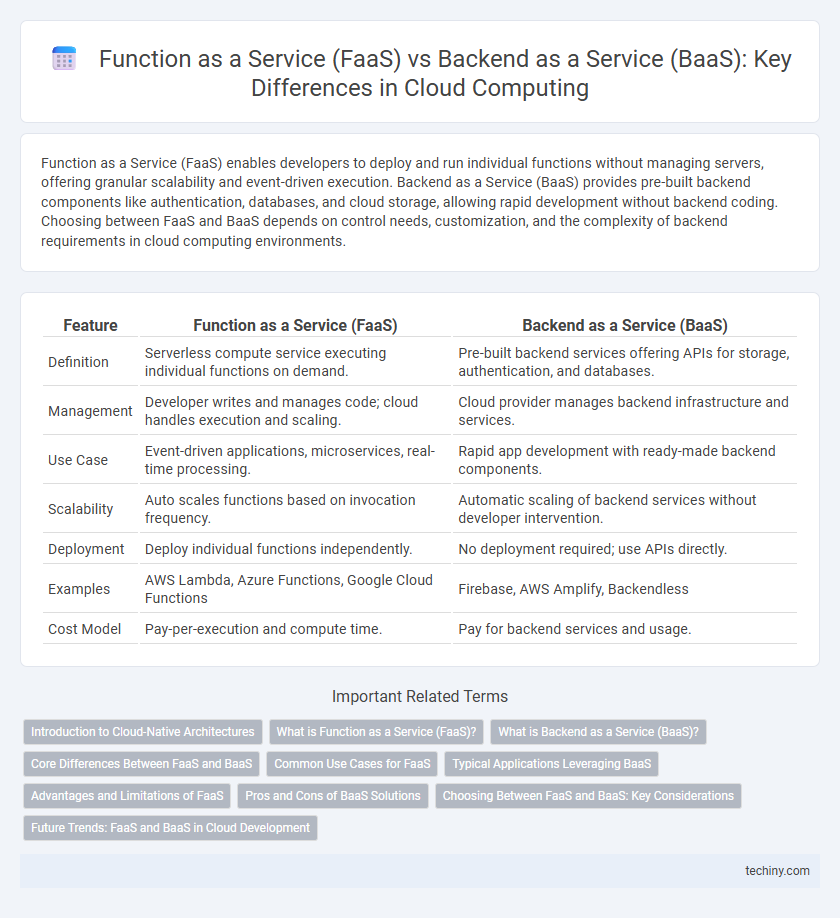Function as a Service (FaaS) enables developers to deploy and run individual functions without managing servers, offering granular scalability and event-driven execution. Backend as a Service (BaaS) provides pre-built backend components like authentication, databases, and cloud storage, allowing rapid development without backend coding. Choosing between FaaS and BaaS depends on control needs, customization, and the complexity of backend requirements in cloud computing environments.
Table of Comparison
| Feature | Function as a Service (FaaS) | Backend as a Service (BaaS) |
|---|---|---|
| Definition | Serverless compute service executing individual functions on demand. | Pre-built backend services offering APIs for storage, authentication, and databases. |
| Management | Developer writes and manages code; cloud handles execution and scaling. | Cloud provider manages backend infrastructure and services. |
| Use Case | Event-driven applications, microservices, real-time processing. | Rapid app development with ready-made backend components. |
| Scalability | Auto scales functions based on invocation frequency. | Automatic scaling of backend services without developer intervention. |
| Deployment | Deploy individual functions independently. | No deployment required; use APIs directly. |
| Examples | AWS Lambda, Azure Functions, Google Cloud Functions | Firebase, AWS Amplify, Backendless |
| Cost Model | Pay-per-execution and compute time. | Pay for backend services and usage. |
Introduction to Cloud-Native Architectures
Function as a Service (FaaS) enables developers to deploy individual functions that automatically scale and execute in response to events, minimizing server management and reducing operational overhead. Backend as a Service (BaaS) provides pre-built backend infrastructure such as databases, authentication, and storage, allowing developers to focus on frontend development while integrating with scalable cloud services. These cloud-native architectures promote agility, faster development cycles, and efficient resource utilization by leveraging managed services and event-driven execution models.
What is Function as a Service (FaaS)?
Function as a Service (FaaS) is a cloud computing model that enables developers to deploy individual functions or pieces of business logic without managing the underlying infrastructure. FaaS automatically scales functions in response to demand, charging only for actual execution time, which optimizes resource utilization and cost efficiency. This serverless architecture supports event-driven applications and rapid development cycles by abstracting server management and enabling seamless integration with other cloud services.
What is Backend as a Service (BaaS)?
Backend as a Service (BaaS) provides developers with ready-made backend infrastructure, including databases, authentication, cloud storage, and server management, enabling rapid app development without handling server-side logic. Popular BaaS providers like Firebase, AWS Amplify, and Parse abstract complex backend functions, reducing development time and operational overhead. BaaS platforms streamline mobile and web app deployment by offering built-in APIs and scalable cloud services tailored for real-time data synchronization and user management.
Core Differences Between FaaS and BaaS
Function as a Service (FaaS) enables developers to execute individual functions in response to events without managing server infrastructure, focusing on event-driven compute execution and granular scalability. Backend as a Service (BaaS) offers pre-built backend services like databases, authentication, and cloud storage, abstracting server-side development and accelerating application deployment. The core difference lies in FaaS providing code execution on demand, while BaaS delivers comprehensive backend resources as managed services.
Common Use Cases for FaaS
Function as a Service (FaaS) is commonly used for event-driven applications, microservices architectures, and real-time data processing, enabling automatic scaling and efficient resource utilization. It excels in use cases such as API backend handling, scheduled tasks, and stream processing, where functions execute in response to triggers without server management. Compared to Backend as a Service (BaaS), FaaS offers greater flexibility in custom code deployment and integration with diverse event sources.
Typical Applications Leveraging BaaS
Typical applications leveraging Backend as a Service (BaaS) include mobile applications, web applications, and IoT solutions that require rapid development with pre-built backend functionalities such as user authentication, database management, and push notifications. BaaS platforms streamline integration with cloud storage, real-time databases, and serverless APIs, enabling developers to focus on frontend experiences without managing infrastructure. Popular BaaS providers like Firebase and AWS Amplify cater to applications needing scalable backend services with minimal configuration.
Advantages and Limitations of FaaS
Function as a Service (FaaS) offers scalable, event-driven execution without server management, reducing operational overhead and enabling rapid deployment of microservices. Its limitations include cold start latency impacting performance and restricted execution time, which may hinder long-running processes. FaaS provides granular control over code execution but often requires more complex integration compared to Backend as a Service (BaaS), which simplifies backend management with ready-to-use services.
Pros and Cons of BaaS Solutions
Backend as a Service (BaaS) solutions streamline app development by providing pre-built backend functionalities like databases, authentication, and cloud storage, reducing time-to-market and eliminating server management. However, reliance on BaaS can lead to vendor lock-in, limited customization, and potential scalability constraints, which may impact flexibility and performance for complex applications. Organizations must weigh the benefits of rapid development and maintenance ease against the drawbacks of dependency and reduced control over backend infrastructure.
Choosing Between FaaS and BaaS: Key Considerations
Choosing between Function as a Service (FaaS) and Backend as a Service (BaaS) depends on application architecture, scalability needs, and development speed. FaaS offers granular, event-driven execution ideal for complex, modular functions, while BaaS provides pre-built backend services that accelerate development with less maintenance. Consider factors such as customization flexibility, cost efficiency, and integration complexity when selecting the optimal cloud computing model.
Future Trends: FaaS and BaaS in Cloud Development
Future trends in cloud development highlight accelerated adoption of Function as a Service (FaaS) due to its granular scalability and event-driven execution that optimizes resource usage. Backend as a Service (BaaS) platforms continue evolving with integrated AI and real-time analytics, simplifying backend management and enhancing developer productivity. Hybrid approaches combining FaaS and BaaS enable more flexible, efficient cloud-native applications, driving innovation across microservices architectures and serverless environments.
Function as a Service (FaaS) vs Backend as a Service (BaaS) Infographic

 techiny.com
techiny.com